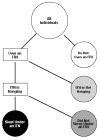Assessing bed net use and non-use after long-lasting insecticidal net distribution: a simple framework to guide programmatic strategies
- PMID: 20482776
- PMCID: PMC2890673
- DOI: 10.1186/1475-2875-9-133
Assessing bed net use and non-use after long-lasting insecticidal net distribution: a simple framework to guide programmatic strategies
Abstract
Background: Insecticide-treated nets (ITNs) are becoming increasingly available to vulnerable populations at risk for malaria. Their appropriate and consistent use is essential to preventing malaria, but ITN use often lags behind ITN ownership. In order to increase ITN use, it is necessary to devise strategies that accurately identify, differentiate, and target the reasons and types of non-use.
Methods: A simple method based on the end-user as the denominator was employed to classify each individual into one of four ITN use categories: 1) living in households not owning an ITN; 2) living in households owning, but not hanging an ITN; 3) living in households owning and hanging an ITN, but who are not sleeping under one; and 4) sleeping under an ITN. This framework was applied to survey data designed to evaluate long-lasting insecticidal nets (LLINs) distributions following integrated campaigns in five countries: Togo, Sierra Leone, Madagascar, Kenya and Niger.
Results: The percentage of children <5 years of age sleeping under an ITN ranged from 51.5% in Kenya to 81.1% in Madagascar. Among the three categories of non-use, children living in households without an ITN make up largest group (range: 9.4%-30.0%), despite the efforts of the integrated child health campaigns. The percentage of children who live in households that own but do not hang an ITN ranged from 5.1% to 16.1%. The percentage of children living in households where an ITN was suspended, but who were not sleeping under it ranged from 4.3% to 16.4%. Use by all household members in Sierra Leone (39.9%) and Madagascar (60.4%) indicate that integrated campaigns reach beyond their desired target populations.
Conclusions: The framework outlined in this paper provides a helpful tool to examine the deficiencies in ITN use. Monitoring and evaluation strategies designed to assess ITN ownership and use can easily incorporate this approach using existing data collection instruments that measure the standard indicators.
Figures





Similar articles
-
Barriers in distribution, ownership and utilization of insecticide-treated mosquito nets among migrant population in Myanmar, 2016: a mixed methods study.Malar J. 2019 May 14;18(1):172. doi: 10.1186/s12936-019-2800-4. Malar J. 2019. PMID: 31088451 Free PMC article.
-
Success of Senegal's first nationwide distribution of long-lasting insecticide-treated nets to children under five - contribution toward universal coverage.Malar J. 2011 Apr 13;10:86. doi: 10.1186/1475-2875-10-86. Malar J. 2011. PMID: 21489278 Free PMC article.
-
Effect of incentives on insecticide-treated bed net use in sub-Saharan Africa: a cluster randomized trial in Madagascar.Malar J. 2010 Jun 27;9:186. doi: 10.1186/1475-2875-9-186. Malar J. 2010. PMID: 20579392 Free PMC article. Clinical Trial.
-
Factors associated with ownership and utilization of insecticide treated nets among children under five years in sub-Saharan Africa.BMC Public Health. 2022 May 10;22(1):940. doi: 10.1186/s12889-022-13347-x. BMC Public Health. 2022. PMID: 35538524 Free PMC article. Review.
-
Effect of user preferences on ITN use: a review of literature and data.Malar J. 2017 Jun 1;16(1):233. doi: 10.1186/s12936-017-1879-8. Malar J. 2017. PMID: 28571583 Free PMC article. Review.
Cited by
-
Reported reasons for not using a mosquito net when one is available: a review of the published literature.Malar J. 2011 Apr 11;10:83. doi: 10.1186/1475-2875-10-83. Malar J. 2011. PMID: 21477376 Free PMC article. Review.
-
Why Use of Interventions Targeting Outdoor Biting Mosquitoes will be Necessary to Achieve Malaria Elimination.Front Physiol. 2012 Jun 12;3:199. doi: 10.3389/fphys.2012.00199. eCollection 2012. Front Physiol. 2012. PMID: 22701435 Free PMC article. No abstract available.
-
The effect of single or repeated home visits on the hanging and use of insecticide-treated mosquito nets following a mass distribution campaign--a cluster randomized, controlled trial.PLoS One. 2015 Mar 16;10(3):e0119078. doi: 10.1371/journal.pone.0119078. eCollection 2015. PLoS One. 2015. PMID: 25774676 Free PMC article. Clinical Trial.
-
Understanding the gap between access and use: a qualitative study on barriers and facilitators to insecticide-treated net use in Ghana.Malar J. 2019 Dec 12;18(1):417. doi: 10.1186/s12936-019-3051-0. Malar J. 2019. PMID: 31831004 Free PMC article.
-
Insecticide-treated net (ITN) ownership, usage, and malaria transmission in the highlands of western Kenya.Parasit Vectors. 2011 Jun 18;4:113. doi: 10.1186/1756-3305-4-113. Parasit Vectors. 2011. PMID: 21682919 Free PMC article.
References
-
- Lengeler C. Insecticide-treated bed nets and curtains for preventing malaria. Cochrane Database of Syst Rev. 2000;2:CD000363. - PubMed
-
- Grabowsky M, Farrell N, Hawley W, Chimumbwa J, Hoyer S, Wolkon A, Selanikio J. Integrating insecticide-treated bednets into a measles vaccination campaign achieves high, rapid and equitable coverage with direct and voucher-based methods. Trop Med Int Health. 2005;10:1151–1160. doi: 10.1111/j.1365-3156.2005.01502.x. - DOI - PubMed
Publication types
MeSH terms
LinkOut - more resources
Full Text Sources
Medical

